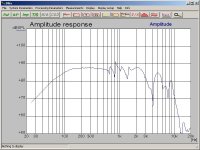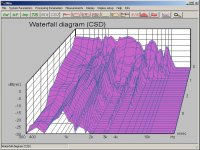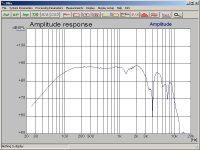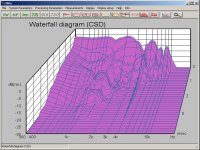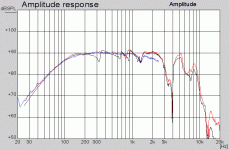Pan said:A waveguide in this situaution may casue worse over all response than leaving the tweeter as is on a more or less flat baffle.
/Peter
Peter
This was a hypothetical guess thats why I didn't pay much attention to it. My experience and data indicate otherwise.
If it weren't for the large cost increase incurred from a dipole or cardiod system, I would indeed try it for the midrange myself. But the additional cost and complexity makes me shy away from it as adding cost to the system does not seem to be such a good idea. People seem to want lower cost smaller systems not higher cost larger ones.
The answer to some questions.
Earl,
The reverberant field measurements were made with the mic at a fixed position. However, I did look at the effect of mic position to verify that the data was truly reverberant. I also looked at changing the orientation. The only difference if the speaker axis was aligned with the mic position as opposed to at 90 degrees saw a slight reduction in the high frequency droop. Obviously in that case some direct sound was still being picked up. Other than that, spatial averaging would only make the data smoother.
Markus,
Sorry, but I'm not going to drag out the system again. The forward facing data should be enough to draw some conclusions about the rear side response. Obviously we are talking about the midrange here since the NaO Mini has no rear tweeter. So, looking at the data below, say 1k Hz it is apparent that the response off axis simple drops in level while remaining flat. That can only happen is the front and rear responses are similar. Ultimately there must be some asymmetry as the frequency increases because of motor blockage, etc. But again, as far as I am concerned the rear response is not so critical. What is important to me is a suitably wide listening window, which I believe +/-20 to 30 degrees is more than enough, and smooth reverberant field, which again the data shows to be the case. Spectral balance of the direct and reverberant sound are the primary issues here for me.
Patrick,
Use of a wave guide would not necessarily work out well here. If a wave guide were implemented I think it would be imperative to use front and rear tweeters. I think there may be better ways to address this issue if it is deemed important enough.
I have to admit that I am curious about there application in box speakers and I have considered using a WG in the ITCA. Not so much to control directivity, but to accomplish the required tweeter acoustic center off set without stepped baffles which would just introduce diffraction. Maybe next year I'll buy one of Earl's Nathan kits and give it a listen. I'm sure is will sound good, but it would sound like a dipole.
Pan,
Haven't been to Madisound in a long time.
Earl,
The reverberant field measurements were made with the mic at a fixed position. However, I did look at the effect of mic position to verify that the data was truly reverberant. I also looked at changing the orientation. The only difference if the speaker axis was aligned with the mic position as opposed to at 90 degrees saw a slight reduction in the high frequency droop. Obviously in that case some direct sound was still being picked up. Other than that, spatial averaging would only make the data smoother.
Markus,
Sorry, but I'm not going to drag out the system again. The forward facing data should be enough to draw some conclusions about the rear side response. Obviously we are talking about the midrange here since the NaO Mini has no rear tweeter. So, looking at the data below, say 1k Hz it is apparent that the response off axis simple drops in level while remaining flat. That can only happen is the front and rear responses are similar. Ultimately there must be some asymmetry as the frequency increases because of motor blockage, etc. But again, as far as I am concerned the rear response is not so critical. What is important to me is a suitably wide listening window, which I believe +/-20 to 30 degrees is more than enough, and smooth reverberant field, which again the data shows to be the case. Spectral balance of the direct and reverberant sound are the primary issues here for me.
Patrick,
Use of a wave guide would not necessarily work out well here. If a wave guide were implemented I think it would be imperative to use front and rear tweeters. I think there may be better ways to address this issue if it is deemed important enough.
I have to admit that I am curious about there application in box speakers and I have considered using a WG in the ITCA. Not so much to control directivity, but to accomplish the required tweeter acoustic center off set without stepped baffles which would just introduce diffraction. Maybe next year I'll buy one of Earl's Nathan kits and give it a listen. I'm sure is will sound good, but it would sound like a dipole.
Pan,
Haven't been to Madisound in a long time.
john k... said:I have to admit that I am curious about there application in box speakers and I have considered using a WG in the ITCA. Not so much to control directivity, but to accomplish the required tweeter acoustic center off set without stepped baffles which would just introduce diffraction.
I could help you with the latter.
Dave
gedlee said:
Peter
This was a hypothetical guess thats why I didn't pay much attention to it. My experience and data indicate otherwise.
Obviously a relatively qualified guess since it goes hand in hand with the measurements John posted shortly after.. ;-)
Also, you did not work with dipoles yet right? That's the specific situation I am adressing. I would possibly use a waveguide (but not necessarily since there are other ways of dealing with teh "jump" from mid to tweeter) if I build boxes again.
If it weren't for the large cost increase incurred from a dipole or cardiod system, I would indeed try it for the midrange myself. But the additional cost and complexity makes me shy away from it as adding cost to the system does not seem to be such a good idea. People seem to want lower cost smaller systems not higher cost larger ones.
Okay, I make speakers to perform well, not to please a potential market. ;-)
/Peter
dlr said:
I could help you with the latter.But you already know what that woud be.
Dave
Says the master of felt-treated baffles.
/Peter
I posted this example with the long box, because it is very easy to see where the standing waves originate from. Clearly not from the driver itself.gedlee said:In this situation you could be right. In my systems I've never seen anything like this, but then I would never use a long box directly behind the woofer for just this reason. When the box spans out laterally behind the woofer it is much less prone to standing waves that would cause this kind of effect.
I guess that the bottom line here is that one can setup a situation where this "box effect" will occur, but one can also just as easily design a box where it is negligable. I prefer to do the later.
I now post a measurement from the same driver in a 5 liter closed, standard, rectangular box. Now it is less easy to see where the standing waves exactly are, because the box dimensions (length, width, heigth) are close together and as such the standing waves are close together in frequency. But again, very easy to measure in the empty box and disappearing to a large extend when the box is filled with wool.
Also in this case he difference was clear in the measurements and it was audible as well.
In fact, there is no single box which I ever build that didn't show this effect. Your SUMMA, with its size, should show a resonance at a couple of hunderd Hz when empty, corresponding with its heigth. If you cannot measure that, that's fine with me, but I know that my measurements are very repeatable.
Attachments
jeroen_d said:first half of third set
This 3rd chart has a different scale (Horizintal) which could lead ti some misinterpretation. Here they are overlayed.
dave
Attachments
planet10 said:
This 3rd chart has a different scale (Horizintal) which could lead ti some misinterpretation. Here they are overlayed.
dave
Yes, you're right. That was a measurement with the sample rate at 6.4kHz. The measurements where done some years ago, unfortunately I deleted the 51kHz sample rate measurement.
john k... said:The answer to some questions.
Earl,
The reverberant field measurements were made with the mic at a fixed position. However, I did look at the effect of mic position to verify that the data was truly reverberant. I also looked at changing the orientation. The only difference if the speaker axis was aligned with the mic position as opposed to at 90 degrees saw a slight reduction in the high frequency droop. Obviously in that case some direct sound was still being picked up. Other than that, spatial averaging would only make the data smoother.
John
If you want to call the measurement a Power Response (i.e. reverberant field) then you have to spatial average it. Its not necessarily true that it would be smoother - you basically have one sample point, the others could all be worse. Basically a 1/3 octave averaged response, like you showed, is only +-3 dB accurate unless you spatial average it. To get to +-1 dB accuracy you need at least six points. If you do not see much change in the response at six points then you are not actually in the reverberant field, there is too much direct field contribution. The reverberant field has to vary by the 3 dB amount or its not difuse. All difuse acoustic fields have this statistical property. This was the crux of Schroeders work.
Jeroen,
Thanks for your posts. They are really helpful.
The graphs show that damping is very effective at higher frequencies within enclosures. It would be interesting to show what happens at lower frequencies. The damping material is less effective at lower frequencies because of the longer wave lengths. I would imagine that once the wave lengths far exceed the box dimensions (e.g, below 200Hz), the frequency response can be quite smooth, unlike the frequency response at the higher frequencies. However, in the time domain, the same problem exists, or possibly even worse, as it takes more time for the bouncing sound waves to be absorbed. Unfortunately, it may be difficult to measure in the lower frequency band.
I had this feeling so I guess that OB has its advantage at lower midrange and upper bass. But when it really gets to the bass region, due to the long wave lengths it possibly does not matter whether it is OB bass or sealed bass.
Regards,
Bill
Thanks for your posts. They are really helpful.
The graphs show that damping is very effective at higher frequencies within enclosures. It would be interesting to show what happens at lower frequencies. The damping material is less effective at lower frequencies because of the longer wave lengths. I would imagine that once the wave lengths far exceed the box dimensions (e.g, below 200Hz), the frequency response can be quite smooth, unlike the frequency response at the higher frequencies. However, in the time domain, the same problem exists, or possibly even worse, as it takes more time for the bouncing sound waves to be absorbed. Unfortunately, it may be difficult to measure in the lower frequency band.
I had this feeling so I guess that OB has its advantage at lower midrange and upper bass. But when it really gets to the bass region, due to the long wave lengths it possibly does not matter whether it is OB bass or sealed bass.
Regards,
Bill
Thanks everyone for a very interesting discussion -
I'm currently working up an OB system, and I'm working on integrating a 2" mid to try and smooth the transition between my 7" mid and 1" tweeter, the region from about 900Hz to 3500Hz. I had in mind particularly the 7" mid's rear LP filtering (somewhere above 1k) and it's beaming (about 2k), and the tweeters inability to reach below 2k smoothly. How come there aren't more designs using a small "upper mid" driver? Complexity? I figured this would maximize smoothness of the on and off axis radiation - am I correct?
I'd love to post measurements for the system, but I'm probably a month or two out from having it ready, unfortunately...
I'm currently working up an OB system, and I'm working on integrating a 2" mid to try and smooth the transition between my 7" mid and 1" tweeter, the region from about 900Hz to 3500Hz. I had in mind particularly the 7" mid's rear LP filtering (somewhere above 1k) and it's beaming (about 2k), and the tweeters inability to reach below 2k smoothly. How come there aren't more designs using a small "upper mid" driver? Complexity? I figured this would maximize smoothness of the on and off axis radiation - am I correct?
I'd love to post measurements for the system, but I'm probably a month or two out from having it ready, unfortunately...

Here is one post that got me interested in a small 'upper mid' driver: seas 4-way dipole
This guy is a big fan of SL's work, and does some very useful woofer measurements (IMO).
This guy is a big fan of SL's work, and does some very useful woofer measurements (IMO).
Pan said:
The 100-110dB output from a soprano is not in the bassrange (in the bass range s singer has much less output) and one W22 driver can put out 136dB at 400Hz in a small box/baffle. Reduce a couple of dB for the open baffle.
The sensitivity is 90dB/2.83V/1m so 100W-300W amp power would be enough.
/Peter
I still stand by every word of my carefully considered post and suggest that to achieve what was talked of, you would actually need to move the decimal one to the right - even in your example - to 1000-3000W. Since this is generally impractical, you are brought back to the core reason there is a burgeoning interest in high efficiency speakers these days.
Yes; something a typical 109dB sensitive horn system can do with ease...Russell Dawkins said:
I still stand by every word of my carefully considered post and suggest that to achieve what was talked of, you would actually need to move the decimal one to the right - even in your example - to 1000-3000W.
Since this is generally impractical, you are brought back to the core reason there is a burgeoning interest in high efficiency speakers these days.
And why they sound free, not strained, with 5 watts, or even less.
cuibono said:How come there aren't more designs using a small "upper mid" driver? Complexity? I figured this would maximize smoothness of the on and off axis radiation - am I correct?
There are other ways of dealing with power response which becomes obvious looking at Johns measurements.
One potential drawback with an upper mid is both more distortion and thermal compression. Sure, the tweeter is happy but how much can a 4" driver take..
The speaker you linked to has a 650Hz crossover which may be fine... or not.
The most dynamic speaker I have heard that also manage to sound clean and relaxed at the same time as being dynamic uses four 8" drivers in a 2.5way system handling over to a tweeter at 3kHz and also assisted by subwoofers below 80Hz. Extreme performance.
/Peter
Russell Dawkins said:
I still stand by every word of my carefully considered post and suggest that to achieve what was talked of, you would actually need to move the decimal one to the right - even in your example - to 1000-3000W. Since this is generally impractical, you are brought back to the core reason there is a burgeoning interest in high efficiency speakers these days.
Please give some argument based on physics and math instead of guesswork. Measurements are fine to.
Just saying "move the decimal" isn't enough for a constructive discussion.
/Peter
- Status
- This old topic is closed. If you want to reopen this topic, contact a moderator using the "Report Post" button.
- Home
- Loudspeakers
- Multi-Way
- Orions sound great because dipole?
